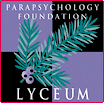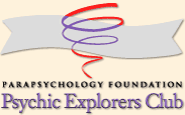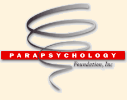 |
 |
| THE BIOGRAPHICAL DICTIONARY OF PARAPSYCHOLOGY GARDNER MURPHY Psychologist, author; president, Society for Psychical Research, London, 1949; president, American Society for Psychical Research, 1962 to present. B. July 8, 1895, Chillicothe, Ohio. B.A., 1916, Yale University; M.A., 1917, Harvard University; Ph.D., 1923, Columbia University. M. 1926. Lois Barclay; 1 d., 1 s. Lecturer in psychology, 1921-25, instructor, assistant professor, 1925-29, Columbia University; professor, chairman of the Department of Psychology, City College of New York, 1940-52; director of research, Menniger Foundation, Topeka, Kansas, 1952 to present. Member: American Psychological Assn. (president, 1944); fellow, American Assn. for the Advancement of Science. A distinguished psychologist, Dr. Murphy has long been interested in psychic research and parapsychology, particulary in the study of telepathy and the survival of bodily death. He joined the Society for Psychical Reseach, London, in 1917, did graduate work at Harvard in the subject as Richard Hodgson Fellow from 1922 to 1925, and served as vice-president of the American Society for Psychical Rsearch from 1940 until 1962, when he was elected president. Dr. Murphy is author of many books on various aspects of psychology and parapsychology, including Historical Introduction to Modern Psychology (1929; 1949); Personality (1947); In the Minds of Men; (1953); Human Potentialities (1958); William James and Psychical Research (with Robert Ballou; 1960); The Challenge of Psychical Research (1961). In his twenty-page entry on parapsychology in the Encyclopedia of Psychology (1946), in which he covers its history and describes experimentation in the field, Dr. Murphy says: "The most prominent concern of psychical research today may be said to be (a) the study of those psychological and physiological conditions under which paranormal phenomena, spontaneous or experimental, appear; (b) the devising of special experiments which will give maximum opportunity for these special conditions to manifest themselves; (c) the resulting development of a consistent repeatable technique; (d) the discovery by all these means of the laws or principles underlying the phenomena; (e) the eventual construction of a system of knowledge which will bind these principles together, so that all of the various types of paranormal phenomena will make a meaningful whole, internally coherent and in meaningful and intelligible contact with the general laws of psychology." Among Dr. Murphy's many contributions to the ASPR Journal, some which reflect his wide interest in the field include "Concentration versus Relaxation in Relation to Telepathy" (Jan. 43); "Psychical Phenomena and Human Needs" (Oct. 1943); "Removal of Impediments to the Paranormal" (Jan. 1944); "An Outline of Survival Evidence" (Jan. 1945); "Difficulties Confronting the Survival Hypothesis" (Apr. 1945); "An Approach to Precognition" (Jan. 1948); "Needed: Instruments for Differentiating between Telepathy and Clairvoyance" (Apr. 1948); "Psychical Research and Personality" (Jan. 1950); "The Natural, the Mystical and the Paranormal" (Oct. 1952); "Triumphs and Defeats in the Study of Mediumship" (Oct. 1957); "Progress in Parapsychology" (Jan. 1959). Residence: 2014 Carnahan, Topeka, Kansas; business address: Menniger Foundation, Topeka. Taken from Helene Pleasants (1964) Biographical Dictionary of Parapsychology with Directory and Glossary 1946-1996 NY: Garrett Publications |
 |

|
 www. parapsychology. org |
||